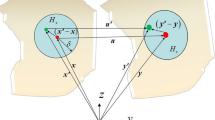Summary
A dissipative flow model is presented to describe dissipative deformation processes in a macroscopic solid continuum. Dissipative process may consist of material plasticity, material damage and other intrinsic mechanical phenomena represented by internal variables. The concept of a dissipative surface is introduced in the paper to distinguish between conservative and dissipative processes. Conventional plastic yielding and damage initiation are expressed by a unique condition which may else include other possible intrinsic mechanical dissipations. The proposed model is based on the principles of irreversible thermodynamics and the minimum free energy theorem. A modified material stability postulate, modified Drucker's postulate, in thermodynamic stress space is also used to obtain the same results.
Similar content being viewed by others
Author information
Authors and Affiliations
Additional information
Received 1 July 1998; accepted for publication 13 January 1999
Rights and permissions
About this article
Cite this article
Li, Q. Dissipative flow model based on dissipative surface and irreversible thermodynamics. Archive of Applied Mechanics 69, 379–392 (1999). https://doi.org/10.1007/s004190050228
Issue Date:
DOI: https://doi.org/10.1007/s004190050228




